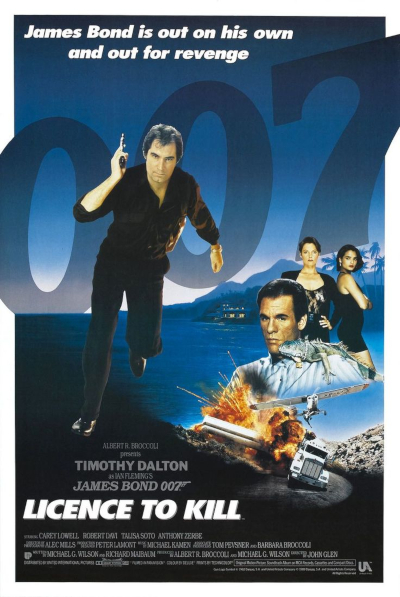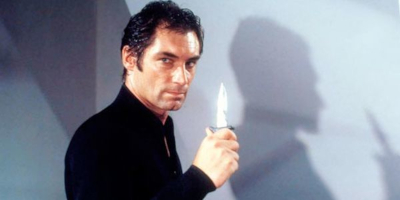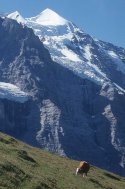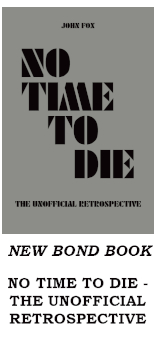|
The Production of Licence To Kill

Although
the script for The Living Daylights had been approached in a somewhat
generic way because it was uncertain who would play Bond (and then for
a time assumed that Pierce Brosnan would play Bond), the story for the
next film was developed in a way to tailor it to Timothy Dalton's
strengths. Both Dalton and the writers wanted the next film to be
tougher and a bit more harder edged than The Living Daylights. "Dalton
was more in the Connery mold so we had to tailor the scripts," said
John Glen. "Roger was so humorous, and we tended to make all these
films verging on comedy. They were very light situations – that was
done purposely. When Timothy came on the scene, we had a fine
Shakespearean actor, but he probably didn’t have the humor that Roger
had so we tailored the scripts accordingly. We made them slightly
blacker or darker, in the sense that we wanted more dramatic
situations. He was more ruthless and more of the original Bond and that
was what we were trying to get back to."The
early plan was to shoot the new Bond film in China and two story
treatments (which included a motorbike chase along the Great Wall) were
written with this in mind. Unfortunately though the success of the film
The Last Emperor nixed this plan and made the idea of going to China
feel far less novel or fresh. In the end it was decided to give the
next film a more tropical setting and Michael G. Wilson, initially
working with Richard Maibaum but then working alone after a writer's
strike, came up with a story that was inspired by Akira Kurosawa's
Yojimbo (which in turn inspired films like A Fistful of Dollars). The
idea was that Bond would play the villains off against one another to
extract revenge for an attack on Felix Leiter. Wilson felt that a
'revenge mission' story would be a good mesh for Timothy Dalton's
darker take on James Bond.Because
of a change in the tax system in Britain, the film would be shot at
Estudios Churubusco in Mexico City rather than Pinewood. Pinewood is a
film and television studio located in the village of Iver Heath in
Buckinghamshire. 'The studio opened on 30 September 1936,' wrote The
Guardian, 'with owners Sir Charles Boot and J Arthur Rank inspired by
Hollywood to create a thriving British film industry, a desire that led
to a series of mergers with other studios over the years - the first in
1938, when Pinewood took over Alexander Korda's Denham Studios.
Pinewood quickly established itself as a location for great British
films. Pinewood's greatest association, however, is with the James Bond
franchise. The first film, Dr No, was shot there in 1962, and despite
fires destroying sets in 1984 and 2006, Bond films have continued to be
filmed at the studio. The Bond stage was rebuilt in 1985, the year
before Pinewood's 50th birthday, and renamed the Albert R. Broccoli
Bond stage in honour of the 007 producer.'This
decision not to use Pinewood, while logical from the point of view of
finances and the needs of the script for a tropical setting, did though
run the risk of losing some Bond 'residue' when it came to tradition
and atmosphere. If anywhere can be called the physical home of James
Bond it is surely Pinewood. The irony is that because of logistical
problems in Mexico, the film wouldn't actually have cost any more money
if it had been based at Pinewood. Timothy Dalton later said he got
rather homesick during the long shoot in Mexico and often wished he
could go home to England and have a pint of beer in a pub! Sadly, the
thin air of the Mexican locations caused Cubby Broccoli to suffer from
breathing problems. He had to leave the production in the end and
couldn't return. The pollution and high-altitude turned out to be
something of an ordeal for the rest of the crew too. Bond
16 would be the first Bond film not to have an original Fleming title
(although there were still unused Fleming titles hanging around like
Risico, The Property of a Lady, and Quantum of Solace). The original
title of Timothy Dalton's second Bond film was License Revoked. A
poster bearing this title appeared at the Cannes Film Festival. On the
first day of shooting, Cubby Broccoli was pictured holding a slate
which clearly says License Revoked. However, when market research
suggested that the general public didn't know what the word 'revoked'
meant this title was dropped in favour of Licence To Kill (a title
which obviously adopted the British spelling). Believe it or not, one
of the main reasons why License Revoked was jettisoned as a title was
that many Americans associated the word 'revoked' with driving licences!John
Glen was asked back to direct Licence To Kill and he later confessed he
was surprised to be brought back again. After four Bond films in
succession, Glen had assumed that EON might try and freshen things up
with a new director for Dalton's second picture. Cubby Broccoli
obviously had a lot of trust and faith in Glen though and saw no reason
to make a change at this point. The Living Daylights had proven that
Glen was perfectly capable of making a less jovial type of Bond film.
John Glen said he was very annoyed at the title change because License
Revoked (or Licence Revoked as it might have become) was perfect for
the story they were going to tell. Glen felt that Licence To Kill was
very generic and lazy in comparison. There
was some speculation at the time that Dalton's second film might borrow
some plot threads from the James Bond continuation novels written by
John Gardner. However this speculation turned out to be misplaced.
While the Bond films continue to mine plot threads, scenes, and
character names from the Fleming books, EON have never shown much
interest in openly adapting anything from the continuation novels. This
was a slight shame because many Bond fans feel that Colonel Sun (where
M is kidnapped) by Kingsley Amis would have made a terrific basis for a
Timothy Dalton Bond film. The
script for Licence To Kill borrowed a few elements from the Fleming
short story The Hildebrand Rarity. The Hildebrand Rarity appeared in
the 1960 short story collection For Your Eyes Only. In the story, while
on holiday in the Seychelles, Bond falls in with dubious millionaire
Milton Krest and is persuaded to join a search for a rare spiked fish
known as The Hildebrand Rarity which Krest must find as part of a tax
dodge. Krest beats his wife with a whip (Franz Sanchez has a similar
habit in Licence To Kill) and poisons countless fish looking for The
Hildebrand Rarity. The
Hildebrand Rarity has a rich exotic atmosphere that makes you feel as
if you are on the boat yourself in these languid and sun-drenched
Indian Ocean waters. The Hildebrand Rarity is not the most exciting
Bond adventure ever to make it into print but it works quite nicely as
a reverse murder mystery and certainly has a memorable method of death
for one character. One can see some elements in this story that grace
Licence To Kill - not least having a character called Milton Krest.
Licence To Kill also borrows from Ian Fleming's shark festooned 1954
novel Live and Let Die - specifically the attack on Felix Leiter. Sadly
though, the gripping sequence where Bond and Solitaire are tied up and
face the prospect of being keelhauled over coral underwater (which
would have made a great scene for Licence To Kill) had already been
adapted in the 1981 Roger Moore film For Your Eyes Only. The
fictional Republic of Isthmus in Licence To Kill is based on Panama.
The villain Franz Sanchez is based on Colombian drug lord and
narcoterrorist Pablo Escobar. John Glen suggested Robert Davi as the
villain Franz Sanchez after watching him a TV film. "I was looking for
a villain who could be the physical equal of Tim’s Bond, in much the
same way Robert Shaw had been the equal of Sean Connery in From Russia
With Love. The balance between hero and villain fascinates me and
Robert Davi played the villainous side of the equation perfectly." Davi
had appeared in films like Raw Deal, Die Hard, and The Goonies. Davi
was delighted to be in a Bond film and even helped test potential the
Bond Girls by playing 007 in auditions when Timothy Dalton was
unavailable.Of his casting,
Robert Davi said - "Tina Broccoli was a fan of mine from Goonies
and she thought I would get along with Cubby. So she set up a dinner
with Cubby and Dana. Cubby and I were both born in Astoria, New York
and of Italian descent, this brought us immediately close. About a year
later I had done Terrorist on Trial. I had gotten tremendous critical
acclaim and was on the cover of all the entertainment sections of the
newspapers. This attention, and having met me, had made Cubby put on
TOT. It so happened Richard Maibaum also was watching it and had called
Cubby to put it on. Cubby said, “I’m watching it.” Richard said,
“That’s the next Bond Villain!” Cubby said, “I think so too.” I was
called to meet Cubby, Michael Wilson and John Glenn the next day and
offered the part."There were a
lot of stories in the media that Cubby Broccoli had offered the part of
the villain to the musician Gene Simmons of Kiss but this obviously
didn't transpire in the end. The Cuban-born Venezuelan-American actress
Maria Conchita Alonso (who unsuccessfully auditioned for the part of
Fatima Blush in Never Say Never Again) was the original choice for the
part of Lupe Lamora. However, after accepting the part, Alonso then had
a change of heart and dropped out of the film. Maria Conchita Alonso's
departure led to fresh auditions and a dozen or so candidates were
tested. The American model Talisa Soto, who had only a few acting
credits at the time, was chosen after Davi said she was the most
beautiful of the women they had tested. Soto later said that Lupe was
much tougher and more morally dubious in the original script and that
the character was changed and softened somewhat. "Lupe was truly a
villain at first, but as we were working there were rewrites. They
decided to soften her up and make her fall in love with James Bond." One
of the first people that director John Glen talked to for the part of
Pam Bouvier was Sharon Stone. At the time, Stone was not yet a star and
her CV consisted of supporting appearances in films like King Solomon's
Mines, Allan Quatermain and the Lost City of Gold, Action Jackson, and
Police Academy 4: Citizens on Patrol. Stone was obviously not chosen in
the end though. The American model and actress Carey Lowell was
eventually chosen to play Pam Bouvier in the film. Unlike Dalton's
first film, Bond would have two love interests in Licence To Kill.
Carey Lowell said she didn't know that much about Bond films when she
got the part so for her research she simply started renting Bond movies
from the video store to watch! The script wasn't finished when Carey
Lowell auditioned so she did her test reading lines from A View To A
Kill. Carey Lowell was amazed at
the attention she suddenly received after her casting and quickly
realised that Bond was a worldwide phenomenon that would probably
overshadow anything she ever went on to do. "I'm just amazed by the
following for the Bond films," she told Cinefantastique. "I don't think
I comprehended how much attention this film would get. It's a little
overwhelming. It's very exciting as well to be in the company of the
people who came before me-Sean Connery and the women. I had somebody
the other day ask me how does it feel to know you're going to be in
book indexes one day? It feels pretty good."John
Rhys-Davies was offered a chance to return as General Pushkin in
Licence To Kill but he declined the offer because he was too busy
shooting Indiana Jones and the Last Crusade. One of the most surprising
additions to the cast was the crooner Wayne Newton as the TV evangelist
Joe Butcher. Newton had apparently contacted Cubby Broccoli and said
he'd always wanted to be in a Bond film. Broccoli granted his wish.
Newton based Joe Butcher on Jimmy Swaggart. Jimmy Swaggart is an
American Pentecostal evangelist who has been on TV and radio for years.
Newton ad-libbed much of Joe Butcher's dialogue in Licence To Kill. Highly
dependable and experienced American actors Anthony Zerbe, Don Stroud,
Everett McGill, and Frank McRae were also given roles in the film and
you certainly couldn't accuse John Glen and EON of not keeping an eye
on up and coming talent because they cast a 21 year-old Benicio del
Toro as the unhinged henchman of Sanchez. The MI6 team of Robert Brown,
Caroline Bliss, Desmond Llewelyn were all back and Anthony Starke was
cast as the young financial whizzkid assistant of Sanchez. Grand L.
Bush, who appeared in Die Hard with Robert Davi, was given a small role
in Licence To Kill as a DEA agent. Desmond
Llewelyn was delighted at the expanded role promised for Q in Licence
To Kill and later said he made more money from this Bond picture than
any of the others. Desmond Llewelyn said that, in his view, Timothy
Dalton was a fantastic actor who had made Bond feel more like a real
person. Caroline Bliss faired less well than Llewelyn in Licence To
Kill. Moneypenny is in the film for about ten seconds and Bliss didn't
even get to play a scene with Timothy Dalton!The
biggest surprise in the cast was the return of David Hedison as Felix
Leiter - a role he had previously played in Live and Let Die alongside
Roger Moore in 1973. At 61, Hedison was nearly twenty years older than
Timothy Dalton so this casting was somewhat eccentric to say the least.
No one was more surprised than Hedison himself at his return! Hedison
had bumped into Cubby and Dana Broccoli at the Bistro Gardens in
Beverly Hills and several weeks later got a call from John Glen
inviting him to be in the film. Hedison was happy to accept this
unexpected chance to be in a James Bond film again. John
Glen had reservations about casting Hedison because of his age but
Cubby Broccoli wanted Hedison so that was that. Glen's reservations
were rather confirmed when Hedison injured both his knees shooting the
PTS moment where Leiter and Bond arrive back at the church (just in
time for Leiter's wedding) by parachute. Priscilla Barnes (already a TV
veteran and later to become a familiar face in low-budget horror
movies) was cast as Della - the doomed wife of Felix. Barnes had
previously starred in the little seen 1980 anthology film Sunday Lovers
with Roger Moore. The title song
for Licence To Kill was originally supposed to be done by Eric Clapton.
There was apparently a plan to eschew a traditional title song and have
a reworked version of the Bond theme over the titles. This would have
been an interesting approach. The Bond franchise hasn't had a purely
instrumental theme since On Her Majesty's Secret Service. One might
argue that given how bland some of the recent Bond theme songs have
been, an upbeat instrumental piece in the vein of OHMSS might be rather
novel and exciting. Obviously, Eric Clapton didn't do the theme music
for Bond 16 in the end though. Gladys Knight was instead chosen to sing
a more traditional (and, as it turned out) enjoyably Bondian song.

The
costume department wanted to put Bond in pastel colours and designer
clothes in Licence To Kill but Timothy Dalton didn't like this plan and
wanted to wear plainer clothes in the film. Dalton argued that Bond was
a spy who had gone rogue so should wear clothes that didn't make him
stand out! "The clothes say so much about Bond," said Dalton. "He's got
a naval background, so he needs a strong, simple colour like dark
blue." It was a far cry from Roger Moore's Bond - who was always
impeccably attired (even in the desert!) and seemed to be recognised
all over the world! Dalton's Bond in Licence To Kill is probably the
most casual and down to earth we've ever seen when it comes to fashion.
Timothy Dalton fought his corner
on the set of Licence To Kill and not just when it came to clothes.
Dalton insisted that Bond should not sleep with Lupe early in the film
(as had been planned) because Lupe had been exploited by men and it
would seem as if Bond was just using her in the same way. Dalton argued
that Bond should be faithful to Pam and resist the attentions of Lupe.
He felt this is what Fleming's Bond would done. This was obviously not
something in the tradition of the Cinematic Bond. Sean Connery's Bond
would have seduced both Pam and Lupe early on in the film and had no
qualms whatsoever! "Tim is a man with passion," said Michael G. Wilson
of disagreements on the set of Licence To Kill. "He expresses himself
very frankly. I never take offence because I can express myself with
some passion too."Licence To Kill
had a budget of $32 million (which ended up at $36 million in the end)
and principal photography ran from the 18th of July to the 18th of
November 1988. In addition to Mexico, filming took place in the Florida
Keys. The Seven Mile Bridge, where Sanchez escapes after the police van
crashes into the sea, was later used in the 1994 James Cameron spy
adventure film True Lies. The mansion belonging to Sanchez in the movie
was owned by friends of Cubby Broccoli. In return for a donation to a
charity of their choice, Broccoli was given permission to use the house
in Licence To Kill. Maurice
Binder's title sequence (which would be his last) is an improvement on
A View To A Kill and The Living Daylights. The title sequence has a
photography theme (with cameras beginning and ending the sequence) and
also uses Former Playboy Playmate Diane Hsu to good effect. Hsu also
has a small role in the film as Hong Kong Narcotics Agent Loti. Gladys
Knight's theme song (composed by by Narada Michael Walden, Jeffrey
Cohen and Walter Afanasieff) is superb and deliberately uses the
opening bars to Goldfinger for that extra Bond residue. I personally
find the theme song for Licence To Kill more satisfying than any of the
theme songs used for the Brosnan or Craig films. The music video for
Licence To Kill was directed by the very talented Daniel Kleinman - who
would replace Maurice Binder as the title credits designerTimothy
Dalton once again impressed the stunt crew by his willingness to do as
many stunts as possible. That's really Dalton being winched below the
helicopter and also Dalton hanging on that tanker truck. Barbara
Broccoli was the producer on the big tanker chase and impressed
everyone with her organisation and authority. You might say that
Barbara finished her apprenticeship on the Dalton films. When the
series returned in the 1990s several years later, Barbara Broccoli was
much more powerful and a fully fledged co-producer with Wilson. The
moment in the tanker chase when Bond jumps from Pam's plane to the
truck had to be delayed for four days because the weather wasn't good. In
an interview many years later, Timothy Dalton said he only got the
script for Licence To Kill about two weeks before it began shooting.
This was something that clearly irritated him as he felt it didn't give
him enough time to prepare for the movie. This fact clearly illustrates
that Dalton had minimal creative control. The only Bond actor who seems
to have exerted a creative control over the franchise is Daniel Craig.
Craig practically became a co-producer on his movies and enjoyed
considerable input into the scripts, choice of writers, choice of
director, and even the artist to do the theme song. Timothy Dalton and
Pierce Brosnan could only dream of such influence. A frustrated Brosnan
couldn't even persuade the producers to hire Monica Belluci rather than
Teri Hatcher for Tomorrow Never Dies.In
a set visit to Licence To Kill, Garth Pearce noted that Timothy Dalton
hadn't let becoming James Bond change him at all as a person. Dalton
still lived in the same modest house he'd had since before he became
Bond and still did all his own shopping. "Why should I change?" said
Dalton. "I can walk around the streets, drink a pint without being
bothered too much and still go shopping for my baked beans. I can't see
how I can begin to play other roles if I'm so far removed from life I
never meet the kind of people I am playing." Dalton said he hardly did
anything apart from acting though did admit that he enjoyed a game of
poker now and again. Timothy
Dalton certainly found himself in the wars shooting Licence To Kill. At
one point Benicio del Toro cut Dalton's hand quite badly shooting the
scene where Bond is captured and put on the conveyer belt grinder but
Dalton - ever the trooper - was soon back on the set to finish the
scene. Dalton said that it was extremely rough shooting some of the
explosive tanker chase scenes (not to mention the climax where sets
light to Felix - triggering a massive explosion) and that it rather put
him off doing stunts in the future. The
shoot was even tougher for Dalton than The Living Daylights and it
seems a few tempers were frayed by the end of the production. The
relationship between Dalton and John Glen was somewhat fractious at the
conclusion of the shoot. "Things ended in a bit of a sour atmosphere,
unfortunately," wrote John Glen of Licence To Kill in his memoir. "I
was feeling a little unwell and Tim wasn't in the best of moods either.
The whole thing was a bit of an ordeal and Tim and I had a bit of a
slanging match across the pool. I don't know whether to put it down to
tiredness at the end of the schedule or the accumulated tension of what
had been an unusually arduous shoot." A
few years later Dalton left the production of Christopher Columbus: The
Discovery after John Glen came onboard as director in place of George
Pan Cosmatos. In his memoir, John Glen said - "While waiting for his
third Bond assignment, Tim had agreed to play Columbus. My arrival,
however, seemed to initiate a change of heart and Tim soon decided he
didn't want to appear in the film after all. I don't know whether Tim
thought that appearing in another John Glen film would typecast him,
but I hope that his departure wasn't entirely due to me. Whatever his
reasons, the official story was that Tim had decided not to play
Christopher Columbus because of 'creative differences' - whatever that
means." It was a lucky escape for Dalton in the end because Christopher
Columbus: The Discovery bombed and swept the board at the Golden
Raspberries.
BUY THE BOOK
© 2023
Alternative 007
|



|





